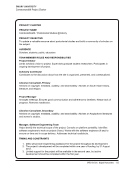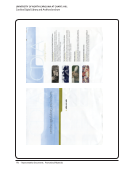38 · Survey Results: Survey Questions and Responses
Graphic design and production, XML editor.
Graphic design software.
Multimedia authoring tools/platforms (Pachyderm, Omeka, etc.)
Repository and specialized microsites/virtual research environments.
Software to support audio, video, and image editing.
Some of the areas not checked include software that we might seek out elsewhere on campus or off campus. Some of
our work in virtual environments is done by a contractor off campus using equipment and software at the university
where she studies (in Texas), or by collaborators at the Smithsonian in DC.
Textual analysis, qualitative analysis, and powerful indexing tools.
Usability testing software, Open Journal System, repository systems, multimedia publishing software.
We are currently testing several Mac-based applications.
We can provide data visualization or concept/mapping software but have not yet done so for a specific project.
We offer Oxygen XML editor which is used by many for TEI encoding.
Web archiving service an electronic publishing service a suite of digital preservation services.
Service Users
13. Who may use the services that support digital humanities projects? Check all that apply. N=47
Faculty 47 98%
Graduate students 41 85%
Post-doctoral or other researchers affiliated with your library or institution 37 77%
Undergraduates 31 65%
Researchers not affiliated with your library or institution 14 29%
Other user category, please describe 11 23%
Depending on the project, this could include many partners from libraries, archives, museums, etc.
Librarians and library staff.
Much of the software and services are available to customers on a walk-in basis more specialized consultation/
collaboration is available to university affiliates.
Graphic design and production, XML editor.
Graphic design software.
Multimedia authoring tools/platforms (Pachyderm, Omeka, etc.)
Repository and specialized microsites/virtual research environments.
Software to support audio, video, and image editing.
Some of the areas not checked include software that we might seek out elsewhere on campus or off campus. Some of
our work in virtual environments is done by a contractor off campus using equipment and software at the university
where she studies (in Texas), or by collaborators at the Smithsonian in DC.
Textual analysis, qualitative analysis, and powerful indexing tools.
Usability testing software, Open Journal System, repository systems, multimedia publishing software.
We are currently testing several Mac-based applications.
We can provide data visualization or concept/mapping software but have not yet done so for a specific project.
We offer Oxygen XML editor which is used by many for TEI encoding.
Web archiving service an electronic publishing service a suite of digital preservation services.
Service Users
13. Who may use the services that support digital humanities projects? Check all that apply. N=47
Faculty 47 98%
Graduate students 41 85%
Post-doctoral or other researchers affiliated with your library or institution 37 77%
Undergraduates 31 65%
Researchers not affiliated with your library or institution 14 29%
Other user category, please describe 11 23%
Depending on the project, this could include many partners from libraries, archives, museums, etc.
Librarians and library staff.
Much of the software and services are available to customers on a walk-in basis more specialized consultation/
collaboration is available to university affiliates.
































































































































































































